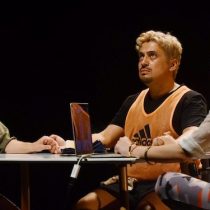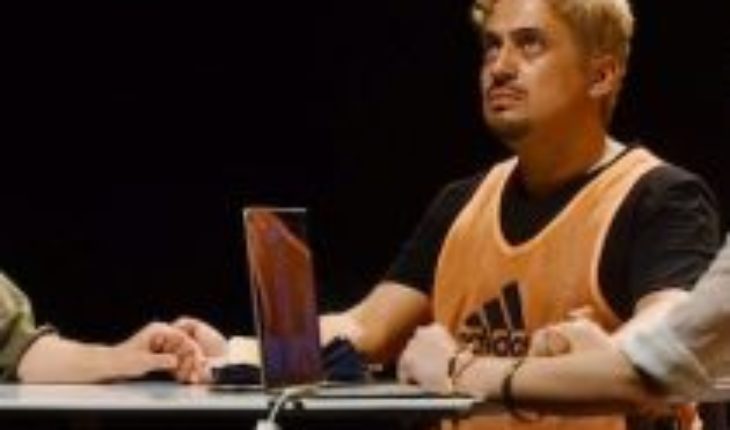
Every discourse, in its own structuring, reveals the keys of its constituent processes and the affiliations it sustains and energizes. From this reflective line, deconstruction can occur at various levels of languages or, if preferred, semiotic systems. In the arts, that aesthetic look is nothing new and since the seventeenth century can be traced in multiple creations. A popular way to generate an aesthetic fabric of these characteristics has been to critically raise awareness of the creative process that allows to generate the artistic work. Velasquez, Sterne, Proust or Pirandello are proof of this.
The theatrical montage “Project Aguirre, from afar they looked slaves” starts from this base, to deliver an investigation regarding the figure of Isidora Aguirre and what we can call his creative legacy, but also (and this is a particularly interesting aspect) of his political discourse, feminine and, by extension, social. In all these aspects, the montage gives a clear lucidity in the treatment of a character at the same time historical, artistic and, also fictional, because, every public or historical figure, as it is understood, also has a mysticism character in its construction.
The management, led by Andreina Olivari and Samantha Manzur, organizes the actions based on the scriptural work and the biography of Isidora Aguirre, being especially – both directors – acute in this, seeing that the two elements are contaminated with each other and that it is impossible to think of the character without her work and vice versa. The staging is very well managed in terms of the semiotic relationship between the various spheres of the montage, in general terms, it is possible to understand that the episodes of the action, the scenery and the investigative development that we appreciate as spectators, seek to reveal, in parallel, through the exploration of the creative group that we see in the tables, the historical sense of a figure like Aguirre, both in terms of memory, as art and culture. From this, the work opens to a hermeneutic gaze that not only reveals the process and the “Isidora Aguirre concept”, but also takes charge of the representational aspect as an extensive tool that manifests a spelling of the world and, therefore, a political position; Personally, moreover, I welcome the fact that this gaze is not uncritical and, on the contrary, exposes the contradictions of all artistic work – anguish, humor, lucidity – and that they do so without modesty.
Dramaturgy is born from the creative team, but the organization of the material is carried out by the directors themselves. This is where you see the weakest dimension of the work. It is not a problem of dialogue or the stage language used to support this field of theatricality, nor is it a problem that it is an episodic work and not a chronological organization of actions (which is often misnamed as “Aristotelian”).
Rather, it is a problem in the total gaze, as a whole, that can be made of the work. In a sense, the assembly fails to completely connect some aspects with each other and blurs the search itself that is rendered, similarly, the testimonial range of dramaturgical/representational elements that are played, do not fully connect with each other, although, it is fair to say, there are extraordinarily right moments in this regard, for example, it is of particular interest to rescue dramaturgy that echo in the work of Aguirre, such as the work of Guillermo Calderón, the memorable scene around the possible (or not) depicting poverty with a frenzy and delirium rarely seen, or the final scene with original audios of essays that travel perfectly in fictional/reality limbo.
Performances in general are undoubtedly also another high point of the montage.
Ariel Hermosilla builds her characters in such a way that it is possible to see the emergence of a certain irony in her performance, the ease with which she assumes the different roles (often a treacherous quality in terms of acting) in her case is a food to the total construction of the work. Hermosilla is able to articulate elements that he progressively add up in his own performance and work, unwrapping his craft throughout the assembly to generate histrionic elements that support the proposal.
Martina Sivori, settles from danger, humor and delivery, with a creative frenzy that is rarely seen on stage. The articulation of gestures, actions, emotionalities through which it travels throughthe assembly, manifest a scenic management that balances the risk and lack of repression with a remarkable technique and actoral quality, managing them with intelligence and scenic intuition, thus generating some of the most memorable scenes of the work, but without falling into repetition or abuse of the same resources, to the extent that these resources, in their work, are multiple; Sivori generates an overflowing and captivating performance.
Tamara Ferreira proposes her performance in order to an actoral structure that gives an account of precision and competence. Ferreira’s performance walks through fewer emotional processes than other cast members, because her characters so require it, however, she is able to show acuity when selecting gestures, actions, vocal forms, the whole of her work is a well integrated mixture between the actress placed on the tables and the manifestation of the semiotic systems from which she creates her characters, in this sense, produces a transparency between the two mimetic forms (for she in while actress also remains semi-otidized in the assembly) so that it adds an active range to the assembly intentions as a whole.
In the integral design, charged by the outstanding Ricardo Romero and Javier Pavez, we see a precise and well thought out selection of the elements that we see on the tables, so that each of them relates functionally and sically to the assembly. Similarly, scenography and changing rooms are also effective within the imaginary that the montage offers, adding communicative forms to the proposal.
Music and sound are in the hands of Nicolás Aguirre and it is also a very well developed language. Aguirre not only generates music that “accompanies” the actions, but produces sound atmospheres that allow to install sensations that support the tensions and scenic tensions of the montage, Nicolás Aguirre does this with special neatness and detail throughout the whole work.
“Project Aguirre, from afar they looked like slaves” is a solid montage that proposes a reading of a historical character not only settled in his biography, but points out his gaze from the artistic work that is born of said character and how this is also a political gesture, posing, in this same process, that the work of memory and reconstruction, must also be so, whenever it builds an ideological interpretation of the world. At times of a social historical character such as those we have experienced, the questions that sustain the montage are not only necessary, but are, without a doubt, an aesthetic proposal that seeks to make its way into the arena of social life.
*The functions of the work “Project Aguirre, by far they looked like slaves” were suspended by the measures taken by COVID-19. The work will re-run as soon as restrictions on cultural events are lifted.
The content poured into this opinion column is the sole responsibility of its author, and does not necessarily reflect the editorial line or position of El Mostrador.





